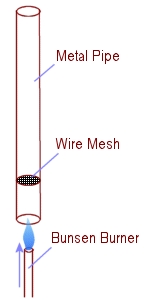Rijke pipe
A Rijke tube is a thermo-acoustic resonator . It is named after Pieter Leonard Rijke , who was the first to describe the underlying effect in 1859.
The Rijke tube (dimensions of the order of magnitude: length: 1 m, diameter 0.1 m) is a tube that is open at both ends and has a heating grille in the lower half. If the pipe is held vertically, the air rises through the heating above the heating grid, creating a vertical flow. Since the heat dissipation of the heating grille to the air depends on the flow speed , it fluctuates when the flow speed fluctuates, which always happens due to the slightest disturbance. The two fluctuations are generally out of phase .
If the heating grille is arranged in the lower half of the pipe as described (at about 1/4 of the length), the fluctuations in heat release and acoustic pressure are in phase , the Rayleigh criterion of thermoacoustics is met, and the natural frequencies of the oscillating air column in the pipe are excited. This is noticeable through a clearly audible whistling .
How the flow is generated in the pipe is irrelevant for the effect. The pipe can also be arranged horizontally if a flow is generated by some type of pump .
Web links
literature
- Elmar Bergeler: The Rijke pipe. In: Physics in our time , 39/2, WILEY-VCH Verlag, 2008
- Konstantin I. Matveev: Thermoacoustic Instabilities in the Rijke Tube: Experiments and Modeling, Ph. D. Thesis, California Institute of Technology, 2003 ( available online ).
